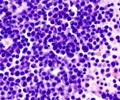Cancer researchers have developed a new strain of mice that should help reveal how an unusual change in a certain gene contributes to a particularly deadly form of AML.
Cancer researchers have developed a new strain of mice that should help reveal how an unusual change in a certain gene contributes to a particularly deadly form of acute myeloid leukemia (AML).
A study of the strain by its developers at the Ohio State University Comprehensive Cancer Center (OSUCCC) suggests that the genetic change comes early in the disease, and that it over-activates a second gene that helps govern blood cell development.The genetic change, known as a partial tandem duplication, is located in a gene called MLL (for mixed-lineage leukemia). A partial tandem duplication is a type of gene mutation that occurs when a section of a gene is repeated, like a stutter in the gene’s DNA.
The new mouse model should help leukemia researchers to learn how this mutation contributes to AML development, and it may lead to new ways to treat, diagnose and perhaps prevent the disease.
The findings were published online Sept. 14 in the Journal of Clinical Investigation.
“When leukemia strikes, it’s like a hurricane arriving without an advance weather forecast – you have no information about how it got there, and it’s a level-5 storm,” says Michael A. Caligiuri, principal investigator of the study and director of the OSUCCC.
“Studying live models like this mouse strain helps us begin to understand the earliest events in the development of leukemia. This in turn will someday allow us to understand what causes leukemia in people, predict who is at greatest risk and prevent leukemia from ever developing in those patients.”
Advertisement
AML will strike an estimated 10,000 Americans this year, and about 45 percent of those will have cancer cells with normal-looking chromosomes. Some 4-7 percent of patients in this group will have cancer cells with this mutation. Their disease is likely to respond poorly to therapy and their remissions will be short.
Advertisement
To make the mouse strain, Caligiuri and his colleagues used genetic engineering techniques to remove a section of the normal MLL gene from one animal and insert it into the MLL gene of another. The result is a strain of mice with a mutation that mimics the one that occurs in human leukemia.
The researchers then looked to see how the mutation affected the animals. The most obvious changes was a missing or rudimentary 13th rib and an additional vertebra in the lower backbone. This suggested the mutation was affecting Hox genes, some of which govern the growth and development of the skeleton and of blood cells.
Next, the researchers examined cells in the bone marrow and spleen that give rise to blood cells. The cells looked normal, as did their numbers. But when the cells were grown in a laboratory test tube, those with the mutation grew far faster and formed much larger colonies than control cells without the mutation.
In addition, cells with the mutation could be used to start new colonies four or more times, while control cells could not. This showed that cells with the mutation lived longer than normal.
Rapid proliferation and unusually long life are features of cancer cells.
Three Hox genes could be involved in the increased proliferation of the progenitor cells. An analysis showed that of the three, the HoxA9 gene was overactive. Its protein was being made at levels much higher than normal.
Furthermore, the researchers also discovered changes that might explain why the gene is overactive. For example, they found that proteins called histones, which help control a gene’s activity, were being altered.
“We show that the histones are being modified in ways that can increase the activity of the HoxA9 gene,” says first author Adrienne M. Dorrance, a graduate student in Caligiuri’s laboratory and the recipient of the Lady Tata Memorial Trust Award for her work on this gene. “We believe that the mutation is somehow activating this modification.”
In spite of these changes, the mouse strain does not develop leukemia.
“The failure of the mice to develop leukemia suggests that the partial tandem duplication occurs early in the leukemic process and that additional mutations are needed for the disease to occur,” Dorrance says. “That’s what we’re now focused on.”
“Ultimately,” Caligiuri says, “we believe that this mouse will further our understanding of how leukemia develops and open up new therapeutic options for this group of AML patients with a poor prognosis.”
Source-Newswise
SRM










